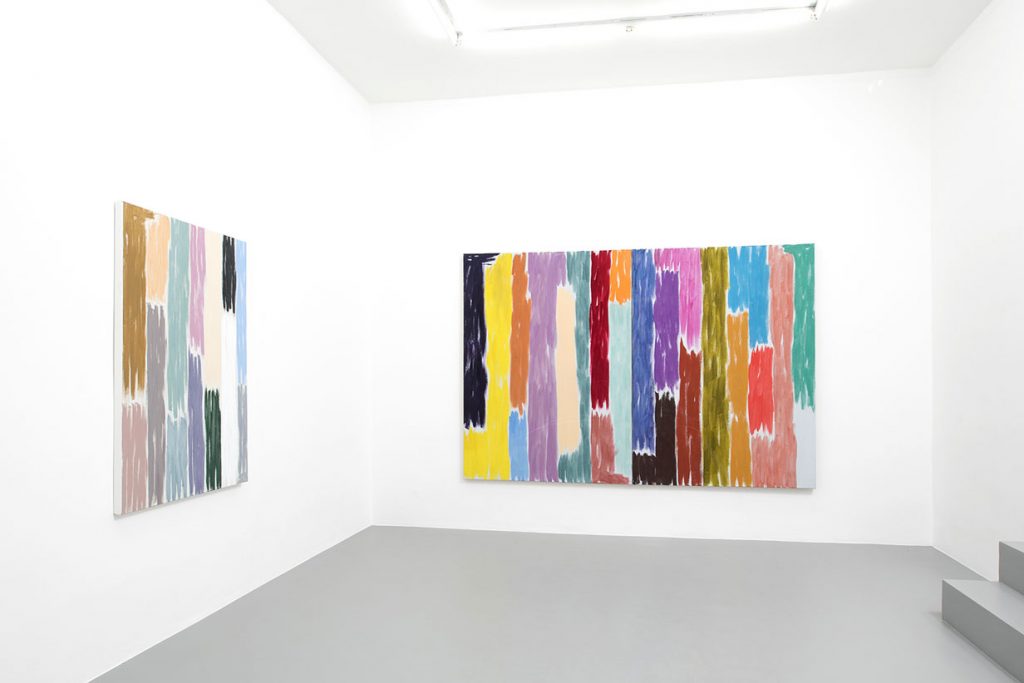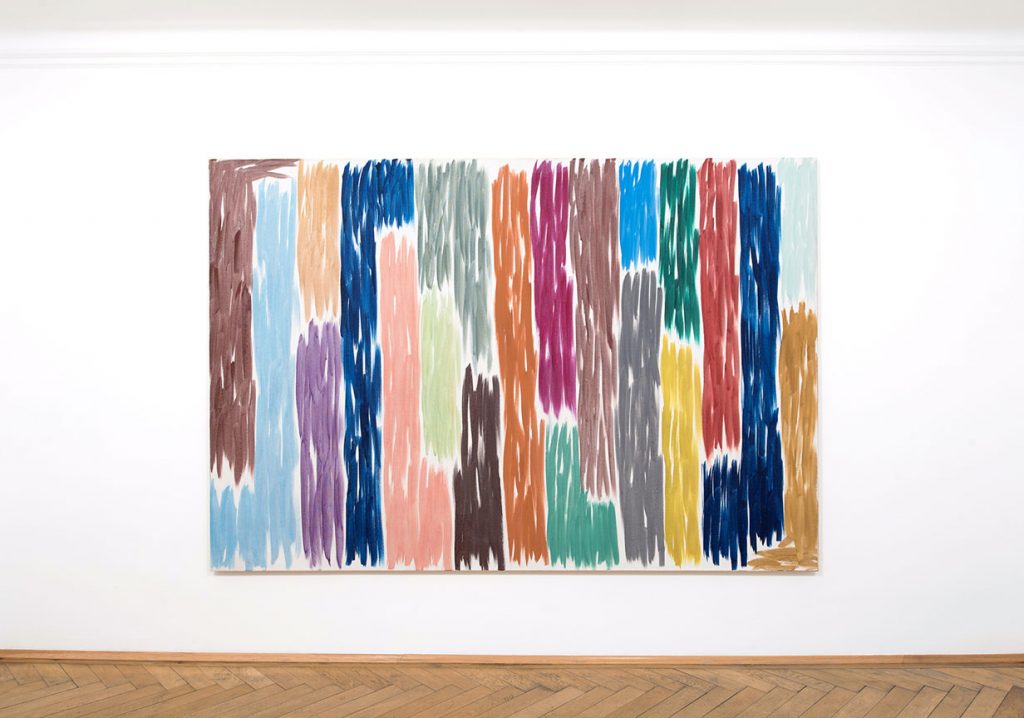






Ein Gespräch zwischen
Thomas von Poschinger, Emanuel Seitz und Lena Tilk.
TvP: Lieber Emanuel, Deine Bilder sind ruppig und lakonisch zugleich. Was bedeutet für Dich Gefühl in Deiner Malerei?
ES: Beim Herstellen der Bilder steht das Gefühl nicht im Vordergrund.
Wenn das Bild fertig ist, schaue ich, welches Gefühl das Bild dann ausstrahlt. Beim Malen spielt mein Gefühl keine Rolle. Meine Befindlichkeiten sind nicht in den Bildern.
LT: Würdest Du sagen, das Malen der Streifen hat etwas Meditatives?
ES: Ja, diese Art der Malerei beruhigt mich. Es ist kein therapeutisches Malen, aber das Malen ist tatsächlich befreit von den Zwängen wie Komposition, Aufbau, etc. Es ist eine relaxte Form von Malerei.
TvP: Soll sich das ganze Bild ins Nichts auflösen oder geht es eher darum, additiv zu sein, das Bild nach vorne zu holen.
Ich habe manchmal den Wunsch, eine Wand zu malen. Aber bei Dir ist dies ja nicht wirklich der Fall.
Es gibt die Zwischenräume.
ES: Es ist ein Bild, aber auch eine Wanderung. Du wanderst ja praktisch das Bild entlang und die Länge der Wanderung lege ich vorher durch das Format fest.
LT: Es gibt ja Entscheidungen, die Du festlegst. Warum die Entscheidung für die grobe Jute?
ES: Jute hat einen Widerstand. Ich kann dünne Farbe verwenden, ohne dass sie zerläuft. Wie bei Holz oder Stoff bleibt die Farbe einfach stehen. Die Farbe muss ganz trocken sitzen.
LT: Die übliche Grundierung einer Leinwand ist ja weiß, warum entscheidest Du Dich nicht für das Weiß?
ES: Eigentlich ist das eine Vorliebe meinerseits. Ich starte gerne mit einem leichten Grau, einem leichten Beige.
Die Temperatur des Bildes wird so gleich ganz anders.
Bei den Landschaften hat mich immer das Düstere interessiert.
LT: Das Landschaftliche klammerst Du aber in diesen Bildern eigentlich komplett aus, oder?
ES: Ja, im Bild gibt es keine Landschaft, aber als Gesamtes erinnert das Bild auch durch sein Format fast an abstrakte Landschaftsgemälde.
LT: Warum malst Du die Bilder mit einem geknickten Malerpinsel?
ES: So überlistest Du Deinen eigenen Gestus. Das Virtuose fällt weg. Zudem passe ich die Größe des Pinsels an das Format der Leinwand an. Bei großformatigen Bildern verwende ich auch einen breiteren Pinsel.
Es ist wichtig, dass man innerhalb des Streifens noch die Struktur und die Breite des Pinsels erkennt.
TvP: Bei Keith Haring kann man ja von einer endlosen Linie sprechen. Könnte man sagen, dass es auch bei Deinen Streifenbildern um einen fortlaufenden Prozess oder Automatismus geht, der nie enden will?
ES: Tatsächlich sind die Bilder fast rein prozesshaft. Auch aufgrund von der Bewegung von links nach rechts.
Alle Bilder male ich von links nach rechts.
A conversation between
Thomas von Poschinger, Emanuel Seitz and Lena Tilk.
TvP: Dear Emanuel, your paintings are raw and laconic at the same time. What role does emotion play for you in your work?
ES: When I create my paintings, emotion is not at the centre.
Only once the painting is finished, I consider what kind of emotion it conveys. But while painting, my emotions do not play a role.
My sensibilities do not appear in the paintings.
LT: Would you say that there is something meditative in painting the stripes?
ES: Yes, this way of painting calms me. It is not therapeutic per se, but the process is in fact liberated from certain constraints such as composition, structure, etc. It is a relaxed way of painting.
TvP: Is the entire painting meant to dissolve into nothingness or is it more about being additive, about bringing the image to the forefront?
I sometimes have the desire to paint a wall. But with you that is not really the case. There are these in-between spaces.
ES: It is a painting, but it is also a journey.
You practically walk along the painting, and I determine the length of the journey in advance through the format.
LT: There are certain decisions you make. Why the choice of coarse burlap?
ES: Burlap has resistance. I can use thin paint without it running.
Like on wood or fabric, the paint just stays put.
The paint has to sit completely dry.
LT: The usual primer for a canvas is white, so why don’t you opt for white?
ES: Actually, it is a preference on my part. I like to start with a light grey, a light beige. It immediately changes the temperature of the painting.
With landscapes, I have always been interested in the sombre.
LT: But you actually exclude elements of landscape completely in these paintings, don’t you?
ES: Yes, there is no landscape in the painting itself, but as a whole, the format of the painting is almost reminiscent of abstract landscape paintings.
LT: Why do you paint your paintings with a bent brush?
ES: In this way you outwit your own gesture. The virtuosity falls away.
In addition, I adapt the size of the brush to the format of the canvas.
For large-format paintings, I also use a wider brush. It is important that you still see the structure and the width of the brush within the stripe.
TvP: With Keith Haring, it is possible to speak of an endless line.
Are your stripe paintings also about an ongoing process or automatism that never wants to end?
ES: As a matter of fact, the paintings are almost entirely processual, also because of their movement from left to right.
I paint all my paintings from left to right.
Text translated by Jennifer Leetsch.